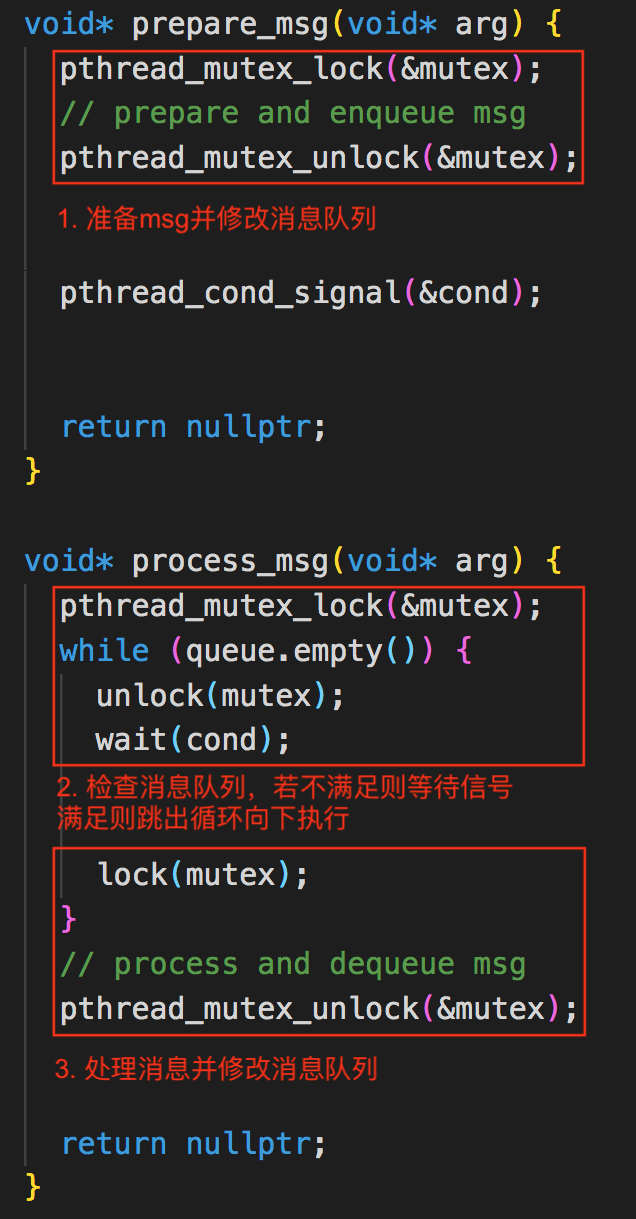Pthreads Basics
Pthreads
Linux内核只为线程提供了底层原语,多线程模型是在用户空间实现的,POSIX对Linux线程库进行了标准化,产生了Pthreads,它是目前C/C++项目的主要线程解决方案。
(一) 线程的创建、终止和错误处理
1. 线程的创建
int pthread_create(pthread_t *thread,
const pthread_attr_t *attr,
void *(*start_routine)(void *),
void *arg);
注:start_routine返回void*,指向Exit Code,如果不需要获取Exit Code,返回NULL即可;此外,用户还可以调用pthread_exit(void* rval_ptr)终止线程并设置指向Exit Code的指针,如果不需要获取Exit Code,传入NULL即可。
Thead ID
类似于Process Id (PID),每个线程都对应一个Thread ID (TID),其类型是pthread_t,POSIX并没有规定它必须是一个算数类型。Process ID由Linux内核分配,在整个系统中是唯一的;Thread ID由Pthreads分配,它只有在所属的进程上下文中才有意义。
// 获取Thread ID
pthread_t pthread_self();
// 比较Thread ID
int pthread_equal(pthread_t t1, pthread_t t2)
2. 线程的终止、Exit Code与资源回收
线程在以下情况下会终止:
-
线程函数执行完毕正常返回,这和main()函数结束类似
- 线程调用pthread_exit()主动终止,这和调用exit()函数类似
void pthread_exit(void* rval_ptr); - 被同一进程内另一个线程通过pthread_cancel()函数取消,这和通过kill()发送SIGKILL信号类似
int pthread_cancel(pthread_t thread);如果线程主动退出(情况1和2)且需要获取Exit Code,需要将线程函数的返回值或rval_ptr指向Exit Code;如果线程被取消,由rval_ptr指定的内存单元就设置为PTHREAD_CANCELED。可以通过pthread_join()获取Exit Code。
Joinable vs. Detached (资源回收)
在任何一个时间点上,一个线程要么处在joinable状态,要么处在detached状态。一个joinable的线程可以被其他线程回收资源,在被其他线程回收之前,相关资源是不释放的;如果一个线程处在detached状态,相关资源在线程终止时立即被系统回收。线程在创建时默认是joinable状态,为了避免资源泄漏,每个joinable的线程都应该要么被显示地被其他线程join,要么将自己设置成detached状态。
// 调用线程阻塞直到thread终止
int pthread_join(pthread_t thread, void **rval_ptr);
// 将thread设置为detached状态
int pthread_detach(pthread_t thread);
[例 ] 获取线程的Exit Code
// 本文仅介绍Pthreads主体逻辑,不做任何防御式编程。
#include <pthread.h>
#include <stdlib.h>
#include <stdio.h>
void* thrd1_func(void* arg) {
printf("thread 1 is running\n");
return (void*)"thread 1 exit\n";
}
void* thrd2_func(void* arg) {
printf("thread 2 is running\n");
pthread_exit((void*)"thread 2 exit\n");
}
int main() {
pthread_t thread1;
pthread_t thread2;
void* ret1 = NULL;
void* ret2 = NULL;
pthread_create(&thread1, NULL, thrd1_func, NULL);
pthread_create(&thread2, NULL, thrd2_func, NULL);
pthread_join(thread1, &ret1);
printf("thread 1 exit code: %s", (char*)ret1);
pthread_join(thread2, &ret2);
printf("thread 2 exit code: %s", (char*)ret2);
return 0;
}
// output
// thread 1 is running
// thread 2 is running
// thread 1 exit code: thread 1 exit
// thread 2 exit code: thread 2 exit
3. 错误处理
多数Pthreads函数在成功时返回0,否则返回error number。
(二) 线程同步
Pthreads使用同步对象实现线程间的同步,本节将介绍其中的Mutex、RWLock、Condition Variable和Barrier。它们的编程范式基本相同:首先初始化一个多个线程可见的共享同步对象,然后各个线程使用该共享对象进行同步。
1. Mutex
// init and destroy
int pthread_mutex_init(pthread_mutex_t* mutex,
const pthread_mutexattr_t* mutex_attr);
pthread_mutex_t mutex = PTHREAD_MUTEX_INITIALIZER;
int pthread_mutex_destroy(pthread_mutex_t* mutes);
// basic
int pthread_mutex_lock(pthread_mutex_t* mutex);
int pthread_mutex_unlock(pthread_mutex_t* mutex);
// try
int pthread_mutex_trylock(pthread_mutex_t* mutex);
// timed
int pthread_mutex_timedlock(pthread_mutex_t* mutex
const struct timespec* tsptr);
2. Readers-Writer Lock
// init and destroy
int pthread_rwlock_init(pthread_rwlock_t* rwlock,
const pthread_rwlockattr_t* attr);
int pthread_rwlock_destroy(pthread_rwlock_t* rwlock);
pthread_rwlock_t rwlock = PTHREAD_RWLOCK_INITIALIZER;
// basic
int pthread_rwlock_rdlock(pthread_rwlock_t* rwlock);
int pthread_rwlock_wrlock(pthread_rwlock_t* rwlock);
int pthread_rwlock_unlock(pthread_rwlock_t* rwlock);
// try
int pthread_rwlock_tryrdlock(pthread_rwlock_t* rwlock);
int pthread_rwlock_trywrlock(pthread_rwlock_t* rwlock);
// timed
int pthread_rwlock_timedrdlock(pthread_rwlock_t* rwlock,
const struct timespec* tsptr);
int pthread_rwlock_timedwrlock(pthread_rwlock_t* rwlock,
const struct timespec* tsptr);
3. Condition Variable
Condition variable允许一组线程根据Condition进行同步。Condition本身是由Mutex保护的,Condition的改变和检查之前都必须先锁住Mutex。
// init and destroy
int pthread_cond_init(pthread_cond_t* cond,
const pthread_condattr_t* cond_attr);
pthread_cond_t cond = PTHREAD_COND_INITIALIZER;
int pthread_cond_sdestroy(pthread_cond_t* cond);
// basic
int pthread_cond_signal(pthread_cond_t* cond);
int pthread_cond_broadcast(pthread_cond_t* cond);
int pthread_cond_wait(pthread_cond_t* cond, pthread_mutex_t* mutex);
// timed
int pthread_cond_timedwait(pthread_cond_t* cond, pthread_mutex_t mutex,
const struct timespec* tsptr);
下面以一个”Producer-Consumer”例子展开对Condition variable的讨论:有两个线程prepare_msg()和process_msg(),prepare_msg()负责生产msg并将其放入消息队列queue中,process_msg()负责消费msg,同步逻辑是如果消息队列中没有msg,那么process_msg()挂起,prepare_msg()每准备好一个msg就发送信号给process_msg(),该信号会唤醒process_msg()使其消费msg。
// 本文仅介绍Pthreads主体逻辑,不做任何防御式编程。
#include <pthread.h>
#include <queue>
#include <iostream>
#include <cassert>
class Message final {
public:
Message(const int val) : val_{val} {}
int GetVal() const { return val_; }
void SetVal(const int val) { val_ = val; }
private:
int val_;
};
constexpr int NUM_MSG = 20;
pthread_mutex_t mutex = PTHREAD_MUTEX_INITIALIZER;
pthread_cond_t cond = PTHREAD_COND_INITIALIZER;
std::queue<Message> queue;
void* prepare_msg(void* arg) {
for (int i = 0; i < NUM_MSG; ++i) {
pthread_mutex_lock(&mutex);
Message msg(i);
queue.emplace(msg);
std::cout << "thrd 0: prepare and enqueue msg (" << msg.GetVal() << ")" << std::endl;
pthread_mutex_unlock(&mutex);
pthread_cond_signal(&cond);
}
}
void* process_msg(void* arg) {
while (true) {
pthread_mutex_lock(&mutex);
while (queue.empty()) { pthread_cond_wait(&cond, &mutex); }
Message msg = queue.front();
queue.pop();
std::cout << "thrd 1: process and dequeue msg (" << msg.GetVal() << ")" << std::endl;
pthread_mutex_unlock(&mutex);
}
}
int main() {
pthread_t producer;
pthread_t consumer;
pthread_create(&producer, NULL, prepare_msg, NULL);
pthread_create(&consumer, NULL, process_msg, NULL);
pthread_join(producer, NULL);
}
// out
// thrd 0: prepare and enqueue msg (0)
// thrd 0: prepare and enqueue msg (1)
// thrd 0: prepare and enqueue msg (2)
// thrd 0: prepare and enqueue msg (3)
// thrd 0: prepare and enqueue msg (4)
// thrd 0: prepare and enqueue msg (5)
// thrd 0: prepare and enqueue msg (6)
// thrd 0: prepare and enqueue msg (7)
// thrd 0: prepare and enqueue msg (8)
// thrd 0: prepare and enqueue msg (9)
// thrd 0: prepare and enqueue msg (10)
// thrd 0: prepare and enqueue msg (11)
// thrd 0: prepare and enqueue msg (12)
// thrd 0: prepare and enqueue msg (13)
// thrd 0: prepare and enqueue msg (14)
// thrd 0: prepare and enqueue msg (15)
// thrd 0: prepare and enqueue msg (16)
// thrd 1: process and dequeue msg (0)
// thrd 1: process and dequeue msg (1)
// thrd 1: process and dequeue msg (2)
// thrd 1: process and dequeue msg (3)
// thrd 1: process and dequeue msg (4)
// thrd 1: process and dequeue msg (5)
// thrd 1: process and dequeue msg (6)
// thrd 1: process and dequeue msg (7)
// thrd 1: process and dequeue msg (8)
// thrd 1: process and dequeue msg (9)
// thrd 1: process and dequeue msg (10)
// thrd 1: process and dequeue msg (11)
// thrd 1: process and dequeue msg (12)
// thrd 1: process and dequeue msg (13)
// thrd 1: process and dequeue msg (14)
// thrd 1: process and dequeue msg (15)
// thrd 1: process and dequeue msg (16)
// thrd 0: prepare and enqueue msg (17)
// thrd 0: prepare and enqueue msg (18)
// thrd 0: prepare and enqueue msg (19)
// thrd 1: process and dequeue msg (17)
// thrd 1: process and dequeue msg (18)
// thrd 1: process and dequeue msg (19)
几个常见的问题:
-
pthread_cond_wait()实现原理,为什么pthread_cond_wait()需要传入一个mutex?
glibc源码:glibc pthread_cond_wait.c
pthread_cond_wait()的实现简化如下:
int pthread_cond_wait(cond, mutex) { unlock(mutex); wait(cond); lock(mutex); }一次完整的生产消费关系如下图所示:

每个红框都是由mutex保护的critical section,Condition的修改和检查均要有mutex保护。传入mutex的原因是希望挂起线程的时候将mutex释放掉,让其他线程修改或检查消息队列,等信号到来唤醒时候再去把mutex抢回来处理消息。
-
Q: 为什么使用while判断状态而不是if?
A: 为了处理在多个线程竞争中某个线程唤醒后Condition仍然不满足的情况。如果发生这种情况,while可以保证线程再次进入阻塞状态等待唤醒信号。
-
Q: pthread_cond_signal()是否可以在由mutex保护的临界区中?
A: 可以,有时候甚至是必须的。只要允许其他线程在pthread_cond_signal()操作前修改消息队列就可以,反之必须放在临界区中。
-
Q: process and dequeue msg的逻辑是否可以放在由mutex保护的临界区外?
A: 不行,这里涉及消息队列的修改,必须放入临界区中。
4. Barrier
Barrier允许多个线程等待,直到指定数量的线程都达到某点,然后从该点继续执行。
// init and destroy
int pthread_barrier_init(pthread_barrier_t* barrier,
const pthread_barrierattr_t* attr,
unsigned int count);
int pthread_barrier_destroy(pthread_barrier_t* barrier);
// basics
int pthread_barrier_wait(pthread_barrier_t* barrier);
Barrier在初始化时指定在允许所有线程继续执行前,必须到达Barrier的线程数目(Barrier Count)。到达pthread_barrier_wait()的线程在未满足Barrier Count的情况下会挂起,等待Barrier Count的满足;如果该线程是最后一个调用pthread_barrier_wait()的线程且满足了Barrier Count,所有线程被唤醒继续向前执行。